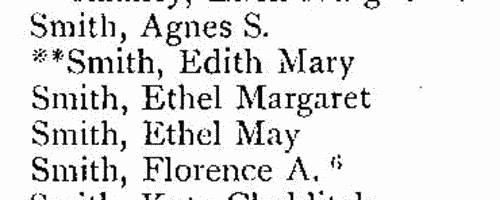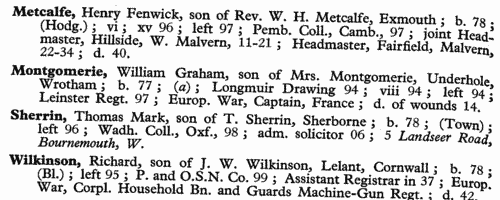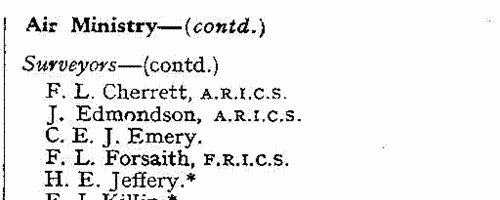Hurndall Surname Ancestry ResultsOur indexes 1000-1999 include entries for the spelling 'hurndall'. In the period you have requested, we have the following 28 records (displaying 21 to 28): Single Surname Subscription | | | Buying all 28 results of this search individually would cost £170.00. But you can have free access to all 28 records for a year, to view, to save and print, for £100. Save £70.00. More... |
These sample scans are from the original record. You will get scans of the full pages or articles where the surname you searched for has been found. Your web browser may prevent the sample windows from opening; in this case please change your browser settings to allow pop-up windows from this site. London Preachers and Mission Hall Keepers (1886)
'The Census of Morning and Evening Attendance in the Churches and Chapels of London, Sunday, October 24th, 1886' was compiled by The British Weekly, employing several thousand persons, and extended to every denomination and sect, giving the number of attendances in the morning (M.) and in the evening (E.), and the name of the incumbent or priest conducting the service. 1500 churches and chapels were found at worship in the city on that day: 'the enumeration was made by actual counting, official estimate being in no case accepted when unconfirmed'. The census covered Kensington, Fulham, Chelsea, St George Hanover Square, Westminster, Marylebone, Hampstead, St Pancras, Islington, Hackney, St Giles, Strand, Holborn, London City, Shoreditch, Bethnal Green, Whitechapel, St George-in-the-East, Stepney, Mile-end and Poplar in Middlesex; St Saviour Southwark, St Olave Southwark, Lambeth, Wandsworth and Camberwell in Surrey; and Greenwich, Lewisham, and Woolwich in Kent. These 29 registration districts comprised a population of about 4,100,000. About half a million attended morning service on that day; 269,799 Anglicans, 142,425 Congregationalists, and relatively smaller numbers for other denominations. In addition, a parallel survey was made of the attendance at the London mission halls and similar minor places of worship: these attracted 203,504 to the three services of the day (morning, afternoon and evening) of whom only 26,096 were specifically Anglican, 49,874 being undenominational.
HURNDALL. Cost: £8.00.  | Sample scan, click to enlarge

| London Priests (1886)
'The Census of Morning and Evening Attendance in the Churches and Chapels of London, Sunday, October 24th, 1886' was compiled by The British Weekly, employing several thousand persons, and extended to every denomination and sect, giving the number of attendances in the morning (M.) and in the evening (E.), and the name of the incumbent or priest conducting the service. 1500 churches and chapels were found at worship in the city on that day: 'the enumeration was made by actual counting, official estimate being in no case accepted when unconfirmed'. The census covered Kensington, Fulham, Chelsea, St George Hanover Square, Westminster, Marylebone, Hampstead, St Pancras, Islington, Hackney, St Giles, Strand, Holborn, London City, Shoreditch, Bethnal Green, Whitechapel, St George-in-the-East, Stepney, Mile-end and Poplar in Middlesex; St Saviour Southwark, St Olave Southwark, Lambeth, Wandsworth and Camberwell in Surrey; and Greenwich, Lewisham, and Woolwich in Kent. These 29 registration districts comprised a population of about 4,100,000. About half a million attended morning service on that day; 269,799 Anglicans, 142,425 Congregationalists, and relatively smaller numbers for other denominations.
HURNDALL. Cost: £8.00.  | Sample scan, click to enlarge

| Veterinary Surgeons
(1890)
The Royal College of Veterinary Surgeons produced an annual register, including lists of fellows, ordinary members and a list of honorary and foreign associates, this edition being revised to February 1890.HURNDALL. Cost: £4.00.  | Sample scan, click to enlarge

| Residents of Surrey
(1895)
Kelly's Directory of Surrey includes this alphabetical Court Directory, listing private residents in the county. In fact, this listing is a little more comprehensive than the main directory, in that it includes residents of some London suburbs that, although in the county of Surrey, are not included in the Surrey directory. Residents are listed surname first, then christian name or initials, and postal address.HURNDALL. Cost: £4.00.  | Sample scan, click to enlarge

| Pianists
(1905)
The calendar of the Trinity College of Music, London, for 1905-1906 includes a section listing pianoforte associates and certificated pianists.HURNDALL. Cost: £8.00.  | Sample scan, click to enlarge

| Boys entering Sherborne School
(1933)
The grammar school at Sherborne in Dorset, which doubtless existed from the creation of the diocese of Sherborne in 705, was refounded by king Edward VI in 1550. At the quatercentenary in 1950, a fourth edition of the Sherborne Register was published, listing boys entering the school during those four centuries. In truth, the materials for this register survive but fitfully before 1823; for some years, no names are known; sometimes all that is known is a surname. But from 1823 onwards the lists and the details get steadily more comprehensive. By the 20th century the boys are listed alphabetically by surname under term of entrance. Surname is given in bold, then christian names, name of father (surname and initials) and address; year of birth; house (a, School House; b, Abbey House; c, The Green; d, Harper House (formerly The Retreat); f, Abbeylands; g, Lyon House; h, Westcott House); whether represented the school at cricket (xi), football (xv), shooting (viii), &c.; year of leaving; summary of degrees, career &c.; and (in italics), address as of 1950. Names in the early lists marked with an asterisk are found inscribed on the oak panelling or on the stone walls of the former schoolroom. (F) in the lists indicates a foundationer, receiving free education: after 1827, when this privilege was restricted to boys from Sherborne and neighbourhood, nearly all foundationers were day-boys.HURNDALL. Cost: £4.00.  | Sample scan, click to enlarge

| Officers of the British Army and of the Indian Army
(1934)
The Half-Yearly Army List, issued By Authority, 30 June 1934, lists all officers in active service at that date, and this list was evidence of the status and rank of the officers contained in it. The entries are set out as a gradation list, by rank, from field-marshals to lieutenants, and within each rank in order of seniority at that rank. Each officer's name (surname first, in capitals, then christian name and present rank (with date of achieving that rank) and regiment &c. are given, for convenience, in bold type, with any national decorations in italics after the name. Each entry also gives date of birth, number of days service in the ranks, dates of service in each rank of officer, particular offices and postings (with dates) and, where appropriate, a summary of war service, and medals. For all but the oldest of the officers then serving, the war service details are for the Great War (1914-1921), and campaigns in Iraq, Waziristan, and the North West Frontier of India. War services are not given in this edition for Indian Army officers, except in that their entries are preceded by a crossed swords symbol where they have seen war service in a theatre of war overseas. After the gradation list of officers, there is a section for the Royal Malta Artillery; and then (pages 1152 to 1185) warrant officers - staff or garrison serjeant-majors, educational serjeant-majors, serjeant-major (physical training and educational) instructors, regimental serjeant-majors (and corporal-majors, farrier-serjeant majors, master gunners, assistant instructors in gunnery, experimental serjeant-majors, artillery clerks, farrier-serjeant-majors, artificer serjeant-majors, clerks of works, mechanist, superintending clerks, draughtsmen, 1st class staff serjeant-majors, transport, supply, conductors, sub-conductors, armourers, armament artificers, headmasters, schoolmasters, marine gunners, and bandmasters. The section for the Royal Army Chaplains' Department lists all chaplains (1st to 3rd class); and that for Queen Alexandra's Imperial Military Nursing Service has all matrons, sisters and staff nurses. The lists of nurses do not give date of birth: all are unmarried. The book concludes with the Yeomen of the Guard, the Honourable Company of Gentlemen-at-Arms, and the King's Body Guard for Scotland, in each case giving name (surname and initials, not christian names), honours, name of late regiment, and date of appointment.
HURNDALL. Cost: £4.00.  | Sample scan, click to enlarge

| British Civil Servants
(1953)
The British Imperial Calendar lists civil servants in Britain, arranged according to the organizational structure of the state, and shows their qualifications and salaries. HURNDALL. Cost: £4.00.  | Sample scan, click to enlarge

|
Research your ancestry, family history, genealogy and one-name study by direct access to original records and archives indexed by surname.
|










